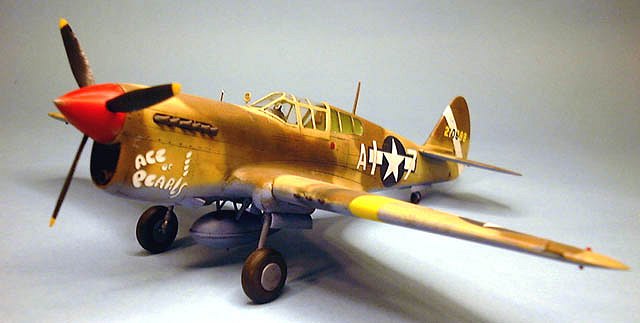
|
KIT # |
488702 |
|
PRICE: |
$24.98 MSRP |
|
DECALS: |
Four options |
|
REVIEWER: |
Tom Choy |
|
NOTES: |
Take your time! |

|
HISTORY |
Tom Cleaver’s hung around P-40s a lot and already has a pretty good introduction to the Merlin-engined P-40, so I’ll just refer you to his article.
Did you know that the famous 99th Pursuit Squadron, better known as the Tuskegee Airmen, flew the P-40? They also flew the P-39 and P-47, but that’s another story. And of course, most of us will probably recognize their flashy red-tailed Mustangs as seen on paintings, prints, airshows, other Tuskegee Airmen models that I have yet to build, and of course, the Tuskegee Airmen movie starring Cuba Gooding Jr. and Lawrence Fishburne.
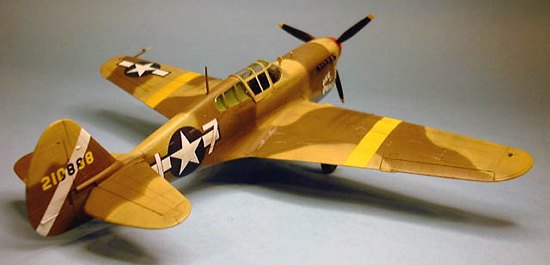 Who were the Tuskegee Airmen? They were a group of
dedicated, determined and brave men who enlisted to become America’s
first black military pilots (However, the first black American to
become a fighter pilot was Eugene Bullard, who signed up with the French
Air Service in World War I), at a time when blacks were considered to
have little in the way of intelligence, courage, skill or patriotism.
The men who enlisted as cadets were mostly college graduates or
undergraduates. No standards were lowered or modified, though in
segregated America, there was much skepticism among the less enlightened
(to put it kindly) about how they would perform. Historically, the Army
Air Corps took the time and effort to get them the best equipment,
training, personnel and support around, despite the widespread belief
that nobody wanted them around. Up the chain of command there were
people who knew this was a good idea and so did everything they could to
make sure the Airmen succeeded. The cadets who did sign up were the best
and brightest of the lot, and as a result, performed above expectations
in training and discipline. The fact that they knew that they had a lot
to prove also served as a major motivator. When they were finally
deployed, they turned out results with a vengeance.
Who were the Tuskegee Airmen? They were a group of
dedicated, determined and brave men who enlisted to become America’s
first black military pilots (However, the first black American to
become a fighter pilot was Eugene Bullard, who signed up with the French
Air Service in World War I), at a time when blacks were considered to
have little in the way of intelligence, courage, skill or patriotism.
The men who enlisted as cadets were mostly college graduates or
undergraduates. No standards were lowered or modified, though in
segregated America, there was much skepticism among the less enlightened
(to put it kindly) about how they would perform. Historically, the Army
Air Corps took the time and effort to get them the best equipment,
training, personnel and support around, despite the widespread belief
that nobody wanted them around. Up the chain of command there were
people who knew this was a good idea and so did everything they could to
make sure the Airmen succeeded. The cadets who did sign up were the best
and brightest of the lot, and as a result, performed above expectations
in training and discipline. The fact that they knew that they had a lot
to prove also served as a major motivator. When they were finally
deployed, they turned out results with a vengeance.
The Tuskegee Airmen became most famous when they
converted to P-51s, and with their brightly painted red tails they became
more of a warning sign than targets to enemy aircraft due to their great
skill, courage and ferocity, which was greatly appreciated by the bomber
crews they often escorted. The 99th’s claim to fame was that
they had never lost a bomber to an enemy fighter on their watch. For
many, it was an exposure to the truth that blacks were regular,
courageous and patriotic people who didn’t want to be at war, but worked
and fought just as hard anyway as any other person because they knew how
important this duty to their country was. It is the sacrifice of the
Tuskegee Airmen and other servicemen
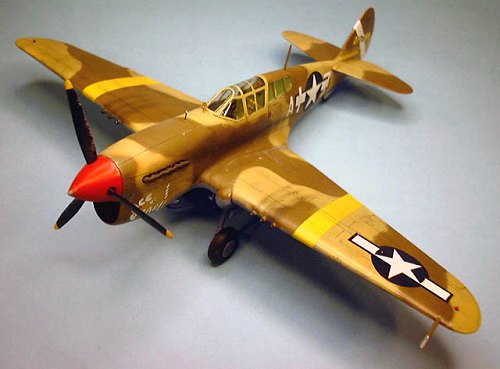 all races and units (notably the 761st
Tank Battalion and 442nd Regimental Combat Team) that made a
significant contribution which brought about the eventual and important
social changes to help achieve racial equality in America.
all races and units (notably the 761st
Tank Battalion and 442nd Regimental Combat Team) that made a
significant contribution which brought about the eventual and important
social changes to help achieve racial equality in America.
You can read more about the Tuskegee Airmen (from which some of the information in this introduction was gleamed from) at the official website of Tuskegee Airmen, Inc., (http://tuskegeeairmen.org/), a non-profit organization dedicated to raising scholarship funds for deserving high school graduates. I have also compiled a list of sites that contain information on the history of black soldiers serving in WW2 at the bottom of this article.
The markings of this aircraft are for 1/Lt. Herman “Ace” Lawson, of the 99th Fighter Squadron, 79th Fighter Group, circa 1944 in Italy. I have not had much luck in finding information about Lt. Lawson, aside from the fact that he has passed away. In hindsight I should have contacted the Tuskegee Foundation.
|
THE KIT |
The kit used for this build is AMTech’s P-40F/L, which is essentially a reboxed AMT P-40 with a modified fuselage sprue and a new resin nose made in conjunction with Hi-Tech of France. The kit looks great in the box (but only while it’s still in the box). The resin is superbly cast and is a solid chunk of resin which is really cool until 5 minutes into the process of sawing off the resin block, which is when your wrist gets really sore and you start wondering when this will ever end. The decals are printed in-house and are superb, except for one or two which were slightly off register, which was more due to the complexity of the decal sheet rather than the fault of the printers. AMTech is really great on customer service and will provide you with a new decal sheet if requested.
|
CONSTRUCTION |
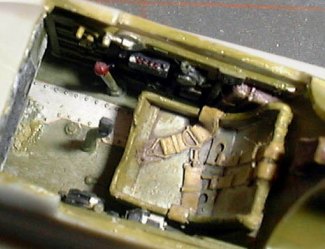 I wanted this model to be special so I got a resin
cockpit from True Details, which was actually made for the Mauve P-40M/N
kit. Cutting Edge makes a great resin cockpit specifically for this kit
but due to budget and time constraints I made do with what I had. Using
the resin parts I discarded the kit seat, floor panel and sidewalls. The
bulkhead was not useable due to its different shape, so I used the kit
bulkhead and scratchbuilt the mounting rails for the seat. I also sanded
the rearward edges sidewall pieces as the kit bulkhead was set at a
different angle compared to the resin bulkhead.
I wanted this model to be special so I got a resin
cockpit from True Details, which was actually made for the Mauve P-40M/N
kit. Cutting Edge makes a great resin cockpit specifically for this kit
but due to budget and time constraints I made do with what I had. Using
the resin parts I discarded the kit seat, floor panel and sidewalls. The
bulkhead was not useable due to its different shape, so I used the kit
bulkhead and scratchbuilt the mounting rails for the seat. I also sanded
the rearward edges sidewall pieces as the kit bulkhead was set at a
different angle compared to the resin bulkhead.
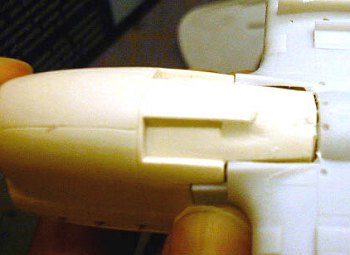 The resin nose would probably have fit perfectly if
I hadn’t been so ham-fisted with the conversion. With my feeble measuring
skills I ended up cutting the left fuselage too short by .5 mm, and the
right fuselage by 2mm. I wrote AMTech to ask for a replacement, which
they promptly rushed to me. The packaged arrived on December 26,
postmarked December 24. This is great customer service! Anyway I sliced
off the nose off the new right fuselage, and messed up anyway – but at
least it’s .5mm so it lines up with the other fuselage half. I glued the
resin nose to the fuselage using epoxy glue, then filled the gap with CA
glue, sanded off the excess and rescribed the lost detail.
The resin nose would probably have fit perfectly if
I hadn’t been so ham-fisted with the conversion. With my feeble measuring
skills I ended up cutting the left fuselage too short by .5 mm, and the
right fuselage by 2mm. I wrote AMTech to ask for a replacement, which
they promptly rushed to me. The packaged arrived on December 26,
postmarked December 24. This is great customer service! Anyway I sliced
off the nose off the new right fuselage, and messed up anyway – but at
least it’s .5mm so it lines up with the other fuselage half. I glued the
resin nose to the fuselage using epoxy glue, then filled the gap with CA
glue, sanded off the excess and rescribed the lost detail.
The lower wing required some modification as well, as a section of the kit Allison engine was part of the lower wing. Sawing off the remaining engine section will let you slide the bulge on the Merlin engine right into the lower wing. Of course since I botched up the fuselage cut I had to go and botch the wing cut too, and ended up sawing through the wing with a little too much gusto, leaving a 1mm gap all around. That gap was promptly fixed with some green putty.
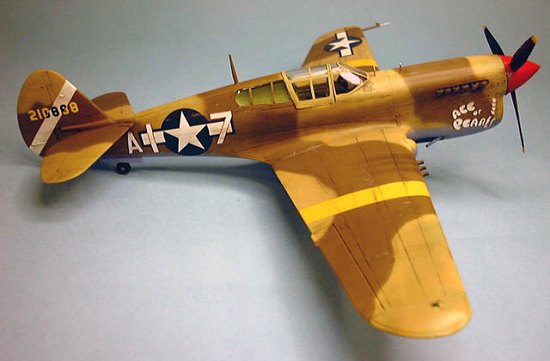 It wasn’t until I glued the upper wings that I
started hating the AMT kit. I ended up with a .5mm gap on the left wing
root, and a 2mm gap on the right wing root! I thought I had mounted the
wings on wrong, but reading other kit builds told me that this was pretty
much normal. I filled in the gaps with some strip styrene and CA glue,
and ended up spending four whole days sanding and resanding that blasted
wing root. At least the tail surfaces fit without a hitch!
It wasn’t until I glued the upper wings that I
started hating the AMT kit. I ended up with a .5mm gap on the left wing
root, and a 2mm gap on the right wing root! I thought I had mounted the
wings on wrong, but reading other kit builds told me that this was pretty
much normal. I filled in the gaps with some strip styrene and CA glue,
and ended up spending four whole days sanding and resanding that blasted
wing root. At least the tail surfaces fit without a hitch!
Pay attention to the main gear covers. Each cover has two lines scribed vertically from top to bottom. Use those to align the covers as you glue them on. For some reason one cover ended up at an angle and I had to break the part off to reattach it. Reattaching it, however, leaves a large gap so I suspect the part was shortshot. It was odd that I didn’t notice it but at that point in time I was getting a little delirious and was rushing to get it done in time.
Finally, the canopy was thicker on one side (think 1 scale inch on the left side of the canopy and 3 scale inches on the right. Maybe P-40s were prone to being shot at from the right side) so I couldn’t display the canopy slid back to show off the interior. I ordered a vacuform canopy but since it hasn’t arrived I’ll have to display the model with the canopy closed.
|
COLORS AND MARKINGS |
After some preshading, I freehand-airbrushed the upper schemes with Testor’s Acryl Light British Gulf War Armor (the closest I could match to Middlestone) and ANA Dark Earth. Using a paintbrush, I touched up the demarcation lines with thinned paint to give the edges a harder edge, as well as to overpaint any overspray. The lower color is Polly Scale’s Azure Blue.
After a coat of Future I applied the decals, which went on without any surprises and did not silver at all. An application of Walther’s Solvaset snuggled down the decals, and when the decals had set the next day I ran my fingernail down the panel lines covered by the decals to blend them into the fuselage more. This would also help any washes applied later.
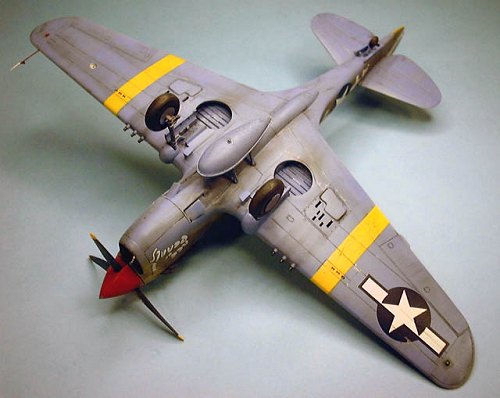 Weathering is a combination washes using black and
burnt sienna oil paints thinned with mineral spirits, and paint chipping
with a silver pencil. Exhaust and gun stains were made using ground up
pastels applied with a wide brush. Finally, everything was sealed with
Testor’s Acryl Dull Coat thinned with 71% rubbing alcohol, which also has
an interesting effect of fading the paint slightly, thus giving it a
sun-bleached appearance.
Weathering is a combination washes using black and
burnt sienna oil paints thinned with mineral spirits, and paint chipping
with a silver pencil. Exhaust and gun stains were made using ground up
pastels applied with a wide brush. Finally, everything was sealed with
Testor’s Acryl Dull Coat thinned with 71% rubbing alcohol, which also has
an interesting effect of fading the paint slightly, thus giving it a
sun-bleached appearance.
I was about to photograph the model when I noticed that Thierry Dekker’s box art showed the P-40 with a ring and bead sight. Confused as to why it would have a ring and bead sight since the P-40 already had a reflector gunsight, I asked around and received several responses from several people, including Tom Cleaver who rapped “ring and bead installed to the right is right.” He also mentioned that the ring and bead sight was a backup as the lightbulb on the reflector gunsight was prone to going out. Since I had already gone so far and worked so hard on it, I went against my better judgment and decided that I could add one more detail to the model. I robbed the ring and bead from an aborted Monogram P-40, thinned out the parts and then proceeded to drill the mounting holes onto the fuselage. Apparently I can’t see in a straight line either, and if the pilot looked through the sights I mounted, he’d be looking at a spot 3° to the right of where the nose was pointing at. Of course, the glue had dried by then and I was forced to cut off the bead and make a new one out of stretched sprue. I finally had it repositioned and (and further in front) so that it is now spaced out correctly and aims where it should.
|
CONCLUSIONS |
AMTech had done a super job on the package deal, though I wish they would have just gone and engineered a new kit instead of relying on the I'd-rather-have-a-monkey-flying-out-of-my-butt-than-build-this AMT offering. Of course, that would have raised the cost, making the kit less accessible to most of us. To their credit AMTech has been very accommodating with requests for replacements, which is more than I can say for a few other companies. I’d say if you’re willing to spend the time, you’ve got a good model on your hands. It’s not perfect, but if Mark Fordham can build a Merlin kit then I sure as heck can build this. The Super Tom Cool-O-Meter gets a 10 out of 10 (something about that Merlin nose gets me) but a measly 3 of out 10 on the Super Tom Fun-O-Meter on the account of the crying and gnashing of teeth.
I still have the remaining decals for P-40L-5-CU, 2/Lt. Erwin R Silsbee, 86th FS, 79th FG (Italy, early 1944); P-40F-20-CU, LtCol Robert Baseler (black P-40 named “Stud”), 325th FG (Tunisia, Sept 1943) and Kittyhawk MK.II, S/Ldr Brian Eaton, No.3 Sqdn, RAAF (Italy, 1943/4) which I won’t be using anymore, so if anyone wants them, send me an e-mail and I’ll mail ‘em over. First come first serve!
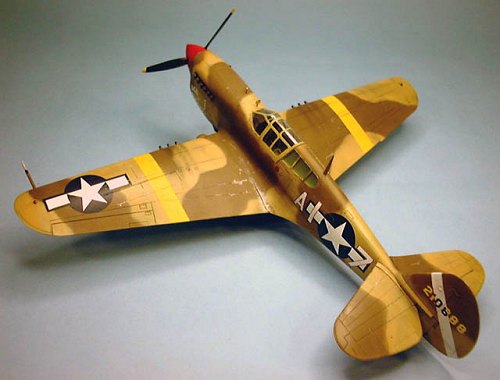 RECOMMENDED ARTICLES
RECOMMENDED ARTICLES
Tuskegee Airmen – Lest We Forget http://www.coax.net/people/lwf/tus_air.htm
The Tuskegee Airmen http://nasaui.ited.uidaho.edu/nasaspark/safety/history/tusk.html
332nd Fighter Group information on acepilots.com http://www.acepilots.com/usaaf_tusk.html
Tuskegee Airmen, Inc – official national organization - http://tuskegeeairmen.org/
“Nobody Wanted Us:” Black Aviators at Freeman Field - http://www.indianahistory.org/heritage/freeman.html
Black Americans in Defense of Our Nation - http://www.shsu.edu/~his_ncp/AfrAmer.html
Lonely Eagles – a look at the Tuskegee program through the eyes of its participants - http://www.af.mil/news/airman/0299/tusk.htm
Address to Tuskegee Airmen, 29th National Convention: Speech by Secretary of Defense Rudy de Leon in San Antonio on August 11, 2000 - http://www.defenselink.mil/speeches/2000/s20000811-depsecdef.html
Eugene Jacques Bullard, the first Black American fighter pilot - http://www.nasm.edu/nasm/pa/nasmnews/history/bhistory/BULLARD.HTM
|
REFERENCES |
Davis, B.O., Jr. (1991): Benjamin O. Davis, Jr.: An Autobiography. Smithsonian Institution Press. Washington, DC.
Francis, C. (1955): The Tuskegee Airmen:The Story of the Negro in the U.S. Air Force Bruce Humphries. Boston, MA.
Holway, J.B. (1997): Red Tail, Black Wings: The Men of America's Black Air Force. Yucca Tree Press. Las Cruces, NM.
McKissack, P., McKissack, F. (1995): Red Tail Angels: The Story of the Tuskegee Airmen of World War II. Walker and Company. New York, NY.
Rose, R.A. (1976): Lonely Eagles: The Story of America's Black Air Force in World War II. Tuskegee Airmen, Inc. Arlington, VA.
Sandler, S. (1992): Segregated Skies: All-Black Combat Squadrons of WWII, Smithsonian Institution Press. Washington, DC.
February 2004
If you would like your product reviewed fairly and fairly quickly, please contact
the editor or see other details in the Note to
Contributors.